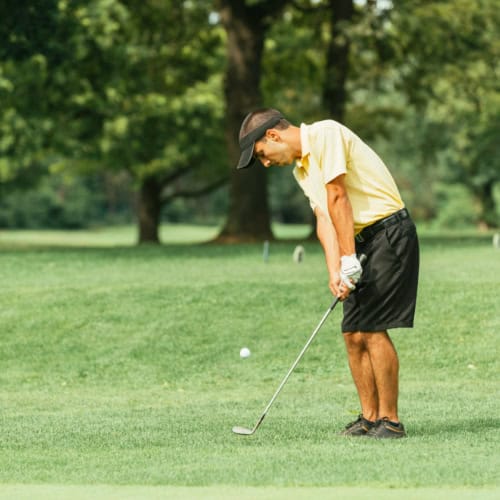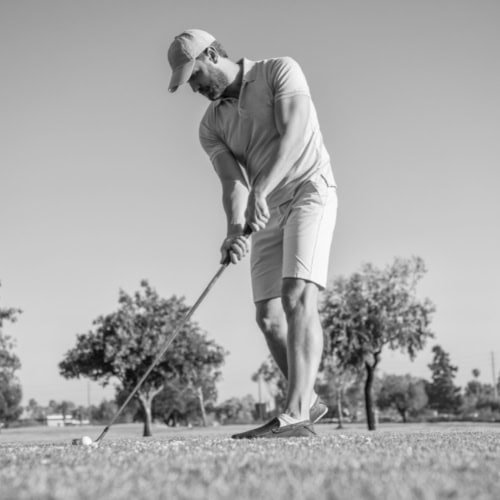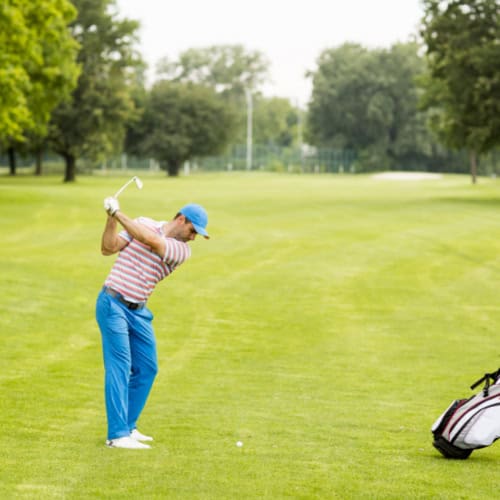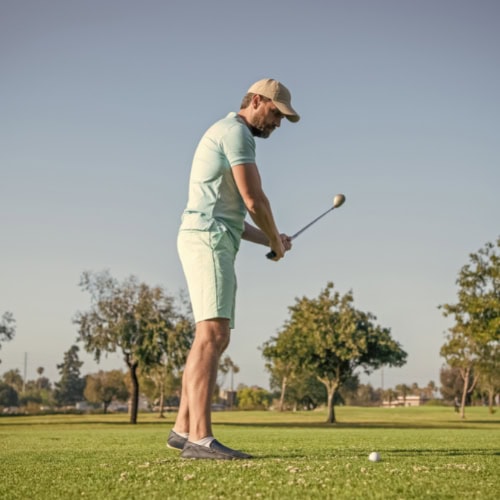If you’re tired of watching your playing partners constantly outdrive you, it may be time to harness the potential of a game-changing concept – Lag.
Lag occurs when the clubhead trails behind your hands during the downswing, creating a 90-degree angle between your lead arm and the club shaft. Imagine a whip cracking – that’s the kind of energy you want to create through impact.
But how can you develop lag in your swing? Get ready to uncover the mystery and take your game to the next level as we explore the key principles and drills that will help you master this essential technique.
- 1) Understanding Lag in the Golf Swing
- 2) Drill 1: One-Handed Swing Drill
- 3) Drill 2: Step and Turn Drill
- 4) Drill 3: Towel Snap Drill
- 5) Common Mistakes and Corrections
- 6) Implementing Lag Drills in Your Practice Routine
- 7) Bonus Drills for Developing Lag
-
8)
Frequently Asked Questions
- 8.1) How often should I practice lag drills to see improvement in my golf swing?
- 8.2) Can developing lag help me hit the ball straighter, or is it primarily for increasing distance?
- 8.3) Are there any specific physical limitations or injuries that might prevent someone from performing lag drills effectively?
- 8.4) How do I know if I’m maintaining the proper amount of lag in my swing during regular play on the course?
- 8.5) Can lag drills be adapted for use with different clubs, such as irons or wedges, or are they mainly designed for driver swings?
- 8.6) Are there any mental techniques or visualizations that can help me better understand and implement the concepts of lag in my swing?
- 8.7) How long does it typically take for golfers to see noticeable improvements in clubhead speed and distance after consistently practicing lag drills?
- 9) Final Thoughts
Understanding Lag in the Golf Swing
To truly harness the power of lag in your swing, it’s essential to have a solid understanding of what it is and how it works. Lag refers to the 90-degree angle formed between your lead arm and the club shaft during the downswing. This angle is the key to generating explosive clubhead speed and achieving pure, solid strikes.
The Importance of Lag for Strike Quality and Clubhead Speed

When you maintain the lag angle throughout your downswing, you create a whip-like effect that allows the clubhead to accelerate rapidly through impact. This acceleration results in increased clubhead speed, which translates to greater distance and improved strike quality.
A proper lag also helps you compress the ball at impact, leading to a more penetrating ball flight and improved accuracy.
Common Misconceptions About Creating Lag
One of the most common misconceptions about creating lag is the belief that you need to forcefully hold the angle or aggressively hinge your wrists. However, true lag is a byproduct of a smooth, natural transition from your backswing to your downswing.
Attempting to force the angle can lead to tension in your arms and wrists, disrupting your swing’s natural flow and ultimately reducing your power and consistency.
The Role of Softness in the Wrists and a Whip-Like Release
To develop proper lag, try to maintain a sense of softness in your wrists throughout your swing. This softness allows your wrists to hinge naturally during your backswing and maintain the lag angle as you transition into your downswing. As you approach impact, your wrists should release in a whip-like manner, allowing the clubhead to accelerate through the ball.
Lag as the Upper Body, Arms and Club Trailing Behind the Lower Body
Another key aspect of lag is the relationship between your upper and lower body during the downswing. As you initiate your downswing, your lower body should lead the way, with your upper body, arms and club trailing behind. This sequence allows you to maintain the lag angle and store energy that will be released through impact.
Drill 1: One-Handed Swing Drill
This drill is designed to help you understand the natural sequence of movements required to create and maintain lag throughout your swing.

The primary purpose of the One-Handed Swing Drill is to isolate the feeling of lag without the added complexity of a full, two-handed swing. By focusing on the movement of just one arm, you can better understand how lag is created and maintained throughout the swing.
Instructions
- Grip the club with only your lead hand (left hand for right-handed golfers, right hand for left-handed golfers).
- Take your stance as you would for a normal shot, with your feet shoulder-width apart and the ball positioned in the center of your stance.
- Begin your backswing, focusing on maintaining a light grip pressure and allowing your wrist to hinge naturally.
- As you reach the top of your backswing, initiate your downswing by starting to rotate your lower body toward the target.
- Allow your upper body, arm, and club to lag behind your lower body as you begin your downswing.
- Accelerate through impact, maintaining the lag angle for as long as possible before releasing the club.
- Complete your follow-through, allowing your arm to fully extend toward the target.
Benefits – Promoting a Natural Lag and Proper Sequencing
The One-Handed swing drill offers several key benefits for golfers looking to improve their lag and overall swing mechanics, including the following:
- Develops a feel for the natural hinging of the wrist during the backswing
- Encourages a lower body-driven downswing, with the upper body, arm and club lagging behind
- Promotes a smooth, sequential transition from backswing to downswing
- Helps ingrain the feeling of maintaining lag throughout the downswing and into impact
When practicing the One-Handed Swing Drill, start with slow, deliberate movements, focusing on the sequence of body rotation and the maintenance of the lag angle. As you become more comfortable with the motion, gradually increase your swing speed while still prioritizing proper form.
Drill 2: Step and Turn Drill
Building upon the foundation established by the One-Handed Swing Drill, the Step and Turn Drill focuses on the crucial role of the lower body in creating and maintaining lag in your swing. This drill emphasizes the importance of proper sequencing and helps you develop a more efficient, powerful swing.

The Step and Turn Drill is designed to help golfers understand and internalize the importance of initiating the downswing with the lower body.
Instructions
- Take your normal stance with the ball in the center.
- Start your backswing, turning your upper body away from the target while keeping your lower body relatively stable.
- As you reach the top of your backswing, step forward with your lead foot (left foot for right-handed golfers) toward the target.
- Initiate your downswing by turning your lower body toward the target, allowing your upper body, arms and club to lag behind.
- As you continue your downswing, feel the sensation of your lead foot planting firmly on the ground, providing a stable base for your swing.
- Accelerate through impact while maintaining the lag angle.
- Complete your follow-through and allow your body to fully rotate toward the target.
Here is a short video (44 sec.) showing how to perform the drill:
Benefits – Encouraging a Lower Body-Driven Downswing and Maintains Lag
The Step and Turn Drill reinforces the importance of initiating the downswing with the lower body, encourages a more dynamic, athletic swing motion, helps maintain the lag angle throughout the downswing by allowing the upper body, arms and club to trail behind the lower body, and promotes a stable, balanced base for your swing, with the lead foot firmly planted on the ground.
When practicing the Step and Turn Drill, start with slow, deliberate movements to internalize the proper sequence, and gradually increase your swing speed as you become more comfortable with the motion.
Drill 3: Towel Snap Drill

This innovative training method utilizes a simple household item – a towel – to help you work on the crucial aspects of creating lag and releasing it through impact. By incorporating this drill into your practice routine, you’ll develop a heightened sense of the proper sequence of movements and timing necessary to generate maximum clubhead speed and power.
Why the Towel Snap Drill Works?
The beauty of the Towel Snap Drill lies in its simplicity. By removing the club from the equation, this drill allows you to zero in on the essential elements of lag and release without any distractions.
The towel serves as a visual and tactile representation of the club, enabling you to feel the lag and snap that occur during a well-executed swing.
How to Perform the Towel Snap Drill?
Performing the Towel Snap Drill is simple. First, fold a standard bath towel in half lengthwise to create a long, narrow strip. Next, grip one end of the folded towel with your trail hand and extend your arm out in front of you. Using your lead hand, grip the other end of the towel, allowing it to hang down in a straight line.
Now, initiate your backswing, maintaining a relatively straight trail arm while allowing your lead arm to fold and create a “hinge” at the elbow. As you reach the top of your backswing, begin your downswing by turning your lower body toward the target and allowing your lead arm to pull the towel down.
Accelerate through the downswing, sensing the towel lag behind your lead arm before snapping forward as you reach the impact position. Finally, follow through, allowing the towel to wrap around your body.
Here is a video (4 min. 17 sec.) to help you nail the towel snap drill:
The Benefits of Mastering the Towel Snap Drill
Mastering the Towel Snap Drill can help with the following:
- Enhanced feel for the proper sequence of movements
- Improved synchronization between your lower body and lead arm
- Increased awareness of the lag and snap sensation
- More dynamic and athletic swing motion
- Fuller, unrestricted follow-through
As you practice the Towel Snap Drill, you should create a smooth, fluid motion and a crisp snap of the towel at the impact position. Start slowly and gradually increase your speed for the best results.
Common Mistakes and Corrections
As you work to develop proper lag, it’s essential to be aware of common mistakes that can hinder your progress. By understanding these pitfalls and implementing the appropriate corrections, you’ll be well on your way to mastering lag and unlocking the full potential of your swing.

Casting the Club Early and Losing Lag Angle
Casting occurs when the hands and wrists release the club too soon, causing the clubhead to move ahead of the hands and resulting in a loss of lag. This premature release can lead to a weak, inefficient strike and a loss of power.
To correct this issue, keep the lag angle for as long as possible during your downswing. Feel as though your hands and wrists are passively holding the angle, allowing your lower body rotation to initiate the downswing and pull the club through impact.
The Importance of Grip Fundamentals for Maintaining Lag
A neutral to slightly strong grip (with the hands rotated slightly towards the target) can help you maintain the lag angle more effectively. Conversely, a weak grip (with the hands rotated away from the target) can make it more difficult to hold the lag angle, leading to early casting and a loss of power.
To ensure a proper grip, start by placing your lead hand on the club, making sure the grip runs from the base of your little finger to the middle of your index finger. Your trail hand should then sit just below your lead hand, with your palms facing each other and your thumbs pointing down the shaft.
Avoiding Sliding Forward and Staying Centered
Another common mistake golfers make when trying to create lag is sliding forward toward the target during the downswing. This lateral movement can cause the club to get stuck behind the body, making it difficult to maintain lag and leading to inconsistent contact.
To avoid this issue, keep a centered posture throughout your swing. Your head should remain behind the ball at impact, with your lower body rotating around a stable spine angle. This will allow you to maintain lag more effectively and create a more powerful, efficient strike.
Initiating the Downswing with the Lower Body
Proper lag is created through a sequence of movements that starts with the lower body. Many golfers, however, mistakenly initiate the downswing with their upper body or arms, leading to a loss of lag and an inefficient strike.
To correct this issue, start your downswing with a rotation of your lower body toward the target. This initial movement should pull your upper body, arms and club along for the ride, allowing you to maintain lag and create a powerful, whip-like release through impact.
Allowing the Arms and Hands to Remain Passive
Finally, it’s important to understand that the arms and hands play a passive role in creating and maintaining lag. Many golfers try to actively manipulate the club with their hands and wrists, leading to a loss of lag and inconsistent contact.
To fix this mistake, keep your arms and hands relaxed and passive throughout your swing. Imagine they are simply holding the club in place, allowing your body rotation to dictate the movement of the clubhead.
Implementing Lag Drills in Your Practice Routine

By focusing on specific aspects of your swing and utilizing various training tools, you can quickly improve your ability to create and maintain lag. Here’s a step-by-step guide to help you effectively integrate lag drills into your practice sessions.
Start with Short Shots and Progress to Longer Ones
When first introducing lag drills into your practice routine, it’s essential to start with short shots and gradually work your way up to longer ones. This approach allows you to focus on the fundamental movements and sensations associated with creating lag without the added complexity of a full swing.
Begin by practicing lag drills with short pitch shots or half-swings. After that, slowly increase the length of your swing until you’re making full swings with your driver.
Use Video Analysis to Compare New Positions to Your Normal Swing
Video analysis is an excellent tool for assessing your progress and identifying areas for improvement as you work on developing lag. By comparing your new swing positions to your normal swing, you can quickly spot differences and make the necessary adjustments.
Set up a camera or use your smartphone to record your swings from both the face-on and down-the-line angles. Review the footage in slow motion, paying close attention to your wrist angles, arm position and body rotation. Look for signs of improved lag, such as a more pronounced wrist hinge and a clubhead that lags behind your hands during the downswing.
While working on lag, it’s also important to focus on other fundamental aspects of your swing. For example, mastering your takeaway is crucial for setting up a proper backswing and downswing sequence. Check out our guide on proven at-home drills to perfect your golf swing takeaway to improve this critical part of your swing.
Downswing Sequencing, Body Rotation and Lead Wrist Position
As you practice lag drills, it’s crucial to keep in mind the key elements that contribute to a powerful, efficient swing. Pay particular attention to your downswing sequencing, body rotation and lead wrist position, as these factors play a significant role in creating and maintaining lag.
When working on your downswing sequencing, concentrate on initiating the movement with your lower body and allowing your upper body, arms and club to follow.
Similarly, maintain a stable spine angle and rotate your body efficiently throughout the swing. Avoid lateral sliding or swaying, as these movements can disrupt your ability to create lag and lead to inconsistent contact.
Finally, pay close attention to your lead wrist position, particularly at impact. Aim to keep your lead wrist flat or slightly bowed, as this helps you maintain lag and compress the ball more effectively.
For a more comprehensive analysis of your swing, consider using advanced technology. Launch monitors can provide detailed data on clubhead speed, ball spin, and launch angle, helping you quantify the improvements in your lag and overall swing efficiency. These devices offer valuable insights that complement video analysis, allowing for a more data-driven approach to perfecting your golf swing
Utilize Technology Like HackMotion to Understand and Improve Wrist Angles
In addition to video analysis, modern technology like HackMotion can provide valuable insights into your wrist angles and help you refine your lag. HackMotion is a wearable sensor that attaches to your glove and measures various aspects of your wrist movement throughout the swing.
With HackMotion, you can gain a deeper understanding of your wrist angles at key points in the swing, such as the top of the backswing and impact. This information can help you identify areas for improvement and track your progress as you work on developing lag.
Bonus Drills for Developing Lag

In addition to the One-Handed Swing, Step and Turn and Towel Snap drills, there are other effective exercises that can help you develop lag. These bonus drills target specific aspects of the swing and provide unique feedback to help you ingrain the proper movements and sensations.
Short-Back Full-Down Drill
The Short-Back Full-Down Drill is designed to help you feel the correct sequence of movements in your swing and promote a dynamic release through impact.
To perform this drill, set up as you would for a normal shot, but take a shorter backswing, stopping when your hands reach about hip height. From this position, initiate your downswing with a full-speed, aggressive motion, focusing on accelerating the clubhead through impact. This drill helps you develop a feel for the proper downswing sequence and promotes a powerful release of the lag angle.
“Ear-To-Ear” Drill
The “Ear-To-Ear” Drill is a great way to work on maintaining lag and improving your swing plane.
Place a club across your shoulders, holding it in place with your arms. Make a slow backswing, and turn your shoulders and hips while keeping the club pointing at your target. Throughout the downswing, pay attention to how the club moves from your back ear to your front ear, maintaining the angle between your arms and the club.
The ear-to-ear drill helps you maintain proper body rotation and promotes a more efficient swing plane.
Baseball Bat Drill
The Baseball Bat Drill is another excellent way to develop a feel for the proper wrist hinge and lag in your swing.
Start by grabbing a baseball bat (or a similar-sized object) and take your normal stance. When swinging, hinge your wrists and create a 90-degree angle between your lead arm and the bat.
As you downswing, keep the bat lag behind your hands before releasing through the impact zone. This way, you can develop a feel for proper wrist hinge and lag, which can translate to your regular golf swing.
The following is a 1 min. 22 sec. video to help you perform the drill:
“Neck” Drill
The “Neck” Drill is will help you maintain lag and improve your swing plane by focusing on a specific body part – your neck.
At setup, place a club across the back of your neck, holding it in place with your hands. swing slowly and keep the club in contact with your neck throughout the motion. At downswing, the club should stay connected to your neck, promoting a more stable swing plane and helping you maintain lag.
With this drill, you will be able to develop a feel for proper body rotation and swing plane, which can lead to more consistent, powerful shots.
Frequently Asked Questions
We have compiled a list of the most commonly asked questions related to lag in golf. The goal is to help you learn as much as possible about this important aspect of the golf swing.
How often should I practice lag drills to see improvement in my golf swing?
It’s recommended to practice lag drills regularly, ideally incorporating them into your practice routine at least 2-3 times per week. Consistency is key when trying to develop new swing mechanics, so aim for frequent, focused practice sessions to see the best results.
Can developing lag help me hit the ball straighter, or is it primarily for increasing distance?
While the primary benefit of developing lag is increased clubhead speed and distance, it can also contribute to improved accuracy. Proper lag promotes a more stable swing plane and better contact with the ball, which can lead to straighter shots.
However, it’s important to note that accuracy also depends on other factors, such as aim, alignment and face control. Get more insights into mastering long and straight golf shots in our guide.
Are there any specific physical limitations or injuries that might prevent someone from performing lag drills effectively?
Golfers with certain physical limitations or injuries, particularly those affecting the wrists, elbows or shoulders, may find it challenging to perform lag drills effectively.
It’s always best to consult with a medical professional or a qualified golf instructor to determine if certain drills are appropriate for your specific condition. They can also suggest modifications or alternative exercises to help you safely develop lag in your swing.
How do I know if I’m maintaining the proper amount of lag in my swing during regular play on the course?
One way to gauge if you’re maintaining proper lag on the course is to pay attention to your ball flight and distance. If you’re consistently hitting the ball with a high, penetrating trajectory and seeing increased distance, it’s a good indication that you’re effectively creating and maintaining lag.
Additionally, you can ask a playing partner to observe your swing or record yourself during a round to check for the key positions and movements associated with proper lag.
Can lag drills be adapted for use with different clubs, such as irons or wedges, or are they mainly designed for driver swings?
Lag drills can be adapted for use with various clubs, not just drivers. The principles of creating and maintaining lag remain the same regardless of the club you’re using. However, you may need to adjust your setup and swing length to accommodate the specific characteristics of each club.
For example, when practicing lag drills with irons or wedges, you may use a slightly shorter swing and a more upright stance compared to your driver setup.
Are there any mental techniques or visualizations that can help me better understand and implement the concepts of lag in my swing?
Yes, mental techniques and visualizations can be powerful tools for internalizing the feel and concept of lag. One helpful visualization is to imagine your arms and club forming a whip, with the handle being your hands and the clubhead being the tip of the whip. Create a smooth, fluid motion where the clubhead lags behind your hands before whipping through the impact zone.
Another technique is to mentally rehearse the key positions and sensations associated with proper lag, such as maintaining the 90-degree angle between your lead arm and the club shaft during the downswing.
How long does it typically take for golfers to see noticeable improvements in clubhead speed and distance after consistently practicing lag drills?
The time it takes to see noticeable improvements varies from golfer to golfer, as everyone learns and adapts at different rates. However, with consistent and focused practice, most golfers can expect to start seeing positive changes in their clubhead speed and distance within a few weeks to a month.
It’s essential to remain patient and committed to the process, as developing proper lag takes time and repetition to ingrain the new movements and sensations into your swing.
Final Thoughts
Mastering lag is of utmost importance for golfers seeking to elevate their performance. By understanding the fundamentals and incorporating effective drills like the One-Handed Swing, Step and Turn and Towel Snap into your practice routine, you’ll develop a more powerful and efficient swing.
Proper sequencing, body rotation and maintaining a flat or slightly flexed lead wrist at impact are all key elements to keep in mind. With dedication and attention to detail, you’ll unlock the transformative power of lag, leading to increased clubhead speed, improved strike quality and longer, more accurate shots.
Happy golfing!





